That Hoarder: Overcome Compulsive Hoarding
Hoarding disorder is stigmatised and people who hoard feel vast amounts of shame. This podcast began life as an audio diary, an anonymous outlet for somebody with this weird condition. That Hoarder speaks about her experiences living with compulsive hoarding, she interviews therapists, academics, researchers, children of hoarders, professional organisers and influencers, and she shares insight and tips for others with the problem. Listened to by people who hoard as well as those who love them and those who work with them, Overcome Compulsive Hoarding with That Hoarder aims to shatter the stigma, share the truth and speak openly and honestly to improve lives.
Episodes
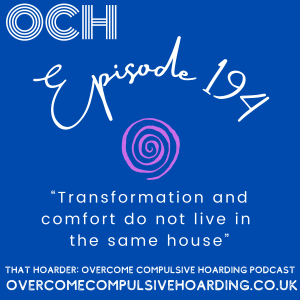
4 days ago
4 days ago
Come to a Dehoarding Accountability Zoom Session: http://www.overcomecompulsivehoarding.co.uk/ticket
Subscribe to the podcast: https://www.overcomecompulsivehoarding.co.uk/subscribe
Podcast show notes, links and transcript: http://www.overcomecompulsivehoarding.co.uk/
Transformation and comfort rarely go hand in hand, especially when it comes to overcoming compulsive hoarding.
In this episode, I talk honestly about why making real change means facing discomfort, based on a quote from Healing Justice London that “transformation and comfort do not live in the same house”.
I challenge us to identify the difference between familiarity and comfort, and share practical ways to push through those tough moments - because growth comes from getting a bit uncomfortable.
If you’re tired of mistaking chaos for comfort, this one’s for you.
“Transformation and comfort do not live in the same house” (Healing Justice London)
The universal truth behind the idea
The necessity of discomfort for real transformation
Discomfort Versus Comfort in the Hoarding Context
Familiarity as a source of “comfort” for those who hoard
Risks of equating familiarity with true comfort
The need for change and its inherent discomfort
Examples of positive outcomes after embracing discomfort
The Reality of Discomfort in Dehoarding
Emotional and physical challenges of dehoarding
Potential for overwhelming feelings and anxiety
Catastrophising and perfectionism surrounding decision-making
Emotional toll of letting go and possible identity implications
Acknowledgement that discomfort does not mean failure
Familiarity Versus Authentic Comfort
Distinction between feeling comfortable and something being familiar
The false sense of control and security provided by clutter
The actual consequences of living in a hoarded home:
Physical hazards (tripping, blocked access, risk in emergencies)
Social isolation and shame
Lack of practical comfort (e.g., not sleeping in one’s own bed)
The hidden, ongoing “slow burn” of stress and discomfort
Motivation and Community
Importance of recognising the true discomfort of living with hoarding
Community connections via the podcast and accountability Zoom sessions
Methods to share resources and reduce isolation
Reframing Discomfort as Growth
Viewing discomfort as a sign of progress rather than a warning
The parallel discomforts of both dehoarding and continuing to hoard
Making conscious choices between competing difficulties
Strategies for Managing Discomfort
Taking small, manageable steps to build resilience
Being gentle and compassionate with oneself during the process
Reaching out for support (friends, family, therapist, peer groups)
The use and benefit of accountability sessions
The Broader Benefits of Transformation
Improved physical space and wellbeing
Increased self-confidence and pride
Better relationships and decreased shame
Regaining practical functionality and freedom at home
Enhanced overall quality of life
Practical Suggestions and Further Resources
Trying a small, uncomfortable but positive task today
References to previous episodes for deeper exploration:
Sitting with discomfort and distress tolerance (Episode 49)
Building resilience (Episode 70 with Dr. Jan Eppingstall)
Links
Podcast ep 190: What if we forgive ourselves, but now we know better, we do better? Choosing compassion over shame in hoarding disorder
Podcast ep 49: Sitting with discomfort: distress tolerance and hoarding – How unconscious distress avoidance might be worsening your problems
Podcast ep 70: Resilience and hoarding with Dr Jan Eppingstall of Stuffology
Enough, the Podcast
Come to a Dehoarding Accountability Zoom session: Accountability Booking Form
Website: Overcome Compulsive Hoarding
Become a Dehoarding Darling
Submit a topic for the podcast to cover
Questions to ask when dehoarding: https://www.overcomecompulsivehoarding.co.uk/podquestions
Instagram: @thathoarderpodcast
Twitter: @ThatHoarder
Mastodon: @ThatHoarder@mastodon.online
TikTok: @thathoarderpodcast
Facebook: Overcome Compulsive Hoarding with That Hoarder
Pinterest: That Hoarder
YouTube: Overcome Compulsive Hoarding with That Hoarder
Reddit: Overcome Compulsive Hoarding with That Hoarder subreddit
Help out: Support this project
Sponsor the podcast
Subscribe to the podcast
Subscribe to the podcast here
Buy your copy of Everything You Need to Know About Hoarding by Dr Lynne Drummond at cambridge.org/EverythingHoarding, and get 20% off with the discount code HOARDING20. #ad
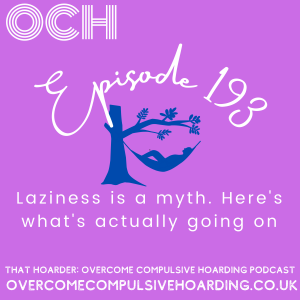
Friday Jul 04, 2025
Friday Jul 04, 2025
Come to a Dehoarding Accountability Zoom Session: http://www.overcomecompulsivehoarding.co.uk/ticket
Subscribe to the podcast: https://www.overcomecompulsivehoarding.co.uk/subscribe
Podcast show notes, links and transcript: http://www.overcomecompulsivehoarding.co.uk/
In this episode, I unpack the myth of laziness and why it’s such a damaging label for people with hoarding disorder.
I’ll break down how blaming ourselves or others for being “lazy” ignores the real barriers - like overwhelm, poor mental health, executive dysfunction and more - and just piles on more shame.
Let’s get honest about what’s actually holding us back and why reframing this idea matters.
The Myth of Laziness in Relation to Hoarding
Revisiting a previous episode’s question: Are hoarders lazy?
Arguments against the idea (hoarded homes require more energy to live in, etc.)
The aversion to external intervention reveals deeper issues than laziness
Societal attitudes towards rest and productivity
Internalised and external accusations of laziness
The damaging effects: shame, isolation, distress
Understanding Hoarding as a Mental Health Issue
Hoarding as a coping method for difficult emotions
Judgments of laziness overlook the disorder’s complexity and nuance
Such labels add barriers to seeking help and reinforce stigma
Consequences of Labelling People who Hoard (or Ourselves) as Lazy
Shame and self-criticism deepen the problem
Laziness as a simplistic explanation that ignores underlying issues
Possible root causes: executive dysfunction, decision-making difficulties, emotional attachment to items, avoidance, depression, physical disability, etc.
The Harmful Cultural Narrative Around Laziness
Societal pressures to be constantly productive
Inaccuracies of the “we all have the same 24 hours” myth
Differences in time and capability due to systemic inequalities
Examples: physical ability, mental health, neurodivergence, responsibilities, discrimination
Moral and Social Implications of the “Lazy” Label
Care tasks are morally neutral (reference to KC Davis, episode 82)
The negative cycle: shame leads to paralysis, makes it harder to seek help and make progress
Laziness label used as a justification for lack of societal support
Political and social consequences for marginalised groups
Importance of community, support, and helping each other
The Danger of Linking Self-Worth to Productivity
The toxic culture of non-stop productivity and hustling
Problems with feeling guilty for resting
The spiral of self-worth being tied to continuous output
The Limiting Nature of the Laziness Concept
It shuts down further exploration of underlying problems
Missed opportunities for self-compassion, empathy, and effective assistance
Underlying Reasons for Struggles That Are Mistaken for Laziness
Lack of motivation: exhaustion, depression, overwhelm
Overwhelm due to the scale of the task
Executive dysfunction (planning, initiating, processing tasks)
Fear (of the process, of making wrong decisions, of consequences)
Fatigue, burnout, and mental health struggles
Being practically or emotionally stuck, lacking skills or knowledge
Societal Structures and Individual Blame
Blame placed on individuals ignores wider systemic and commercial influences
Industries profit from reinforcing personal inadequacy (beauty industry analogy, storage solutions)
The cycle of self-blame, shame, and attempts to “fix” via consumerism
Breaking the Cycle and Moving Forward
Recognising the myth of laziness enables real progress
Compassion, curiosity, and support as healthier responses
Encouragement for self-acceptance and seeking genuine solutions
Buy your copy of Everything You Need to Know About Hoarding by Dr Lynne Drummond at cambridge.org/EverythingHoarding, and get 20% off with the discount code HOARDING20. #ad
Links
Podcast ep 57: Are hoarders lazy? I think you’d be surprised…
Podcast ep 82: Dehoarding when you’re drowning with KC Davis of Struggle Care
Podcast ep 112: Executive function, executive dysfunction and hoarding with Dr Jan Eppingstall
Podcast ep 186: 10 executive dysfunction tips and tricks to help people who hoard, whether we have ADHD or are neurodivergent or not – Hoarding Awareness Week 2025
Podcast ep 183: ADHD, executive dysfunction and creating hacks and systems to reduce clutter chaos, with Carrie Lagerstedt
Podcast ep 162: From Fibble to Focus: Defibble your executive dysfunction with Jo Cavalot
Podcast ep 188: 12 ways to make decision-making easier (and why people who hoard find it so hard to make decisions in the first place!)
Podcast ep 139: Chronic disorganisation with Jo Cooke of Hoarding Disorders UK
Podcast ep 107: Things that look like hoarding but aren’t: ADHD, depression, autism, OCD, OCPD and more
Enough, the Podcast
Come to a Dehoarding Accountability Zoom session: Accountability Booking Form
Website: Overcome Compulsive Hoarding
Become a Dehoarding Darling
Submit a topic for the podcast to cover
Questions to ask when dehoarding: https://www.overcomecompulsivehoarding.co.uk/podquestions
Instagram: @thathoarderpodcast
Twitter: @ThatHoarder
Mastodon: @ThatHoarder@mastodon.online
TikTok: @thathoarderpodcast
Facebook: Overcome Compulsive Hoarding with That Hoarder
Pinterest: That Hoarder
YouTube: Overcome Compulsive Hoarding with That Hoarder
Reddit: Overcome Compulsive Hoarding with That Hoarder subreddit
Help out: Support this project
Sponsor the podcast
Subscribe to the podcast
Subscribe to the podcast here
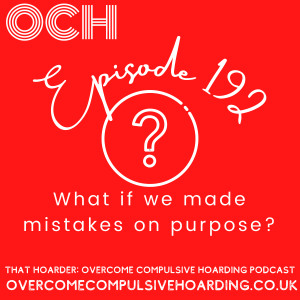
Friday Jun 27, 2025
Friday Jun 27, 2025
Come to a Dehoarding Accountability Zoom Session: http://www.overcomecompulsivehoarding.co.uk/ticket
Subscribe to the podcast: https://www.overcomecompulsivehoarding.co.uk/subscribe
Podcast show notes, links and transcript: http://www.overcomecompulsivehoarding.co.uk/
Today I’m talking about why letting yourself make mistakes - like running out of everyday items or doing things imperfectly - can actually help if you’re struggling with hoarding.
From challenging perfectionism to rethinking the fear of scarcity, I’ll share how embracing messiness can move us forward. Plus, I’ll offer practical ideas for easing those fears and making progress, one small, imperfect step at a time.
Announcement of new dates for Dehoarding Accountability Zoom Sessions.
Aimed at connecting people who hoard for conversation and simultaneous decluttering.
Details on how to get tickets and availability through several upcoming months.
The Value of Making Mistakes
Challenging the idea of perfection and fear of making mistakes.
Proposing the benefits of allowing oneself to:
Make more mistakes.
Run out of things occasionally.
Do things imperfectly or “half-arsed.”
Identifying how fear of mistakes and perfectionism can keep people stuck in hoarding behaviours.
Perfectionism and Fear of Scarcity
Perfectionism:
Fear of making the “wrong” decision leads to inaction or keeping everything.
Uncertainty about the future and anxiety about discarding items.
All-or-nothing thinking: If it can't be done perfectly, it’s not worth starting.
Personal reflection on the struggle with perfectionist tendencies.
Fear of Scarcity:
“Keep it just in case” mentality.
Stemming from past experiences of poverty or deprivation.
How personal history and upbringing foster scarcity-based behaviours.
Recognition that such fears can be irrational and still hold significant power.
How this fear leads to over-acquisition and reluctance to discard.
Addressing Perfectionism and Scarcity (Mindset Shifts)
Techniques to gently challenge perfectionism and scarcity fears.
Reframing mistakes as learning opportunities rather than failures.
Allowing for experimentation as a method of progress.
Embracing Mistakes as a Path Forward
Learning from mistakes as a source of growth and behaviour change.
Normalising occasional regrets over discarding or not acquiring something.
Comparing the cost of keeping everything versus the occasional “mistake.”
Observing emotional responses to mistakes as a way to learn and build decision-making confidence.
Encouragement to start with low-risk decisions and build up “dehoarding muscle” gradually.
Allowing Things to be Done Imperfectly
Encouragement to “do things badly” rather than waiting for perfect execution.
“Done is better than perfect” as a motivating principle.
The danger of all-or-nothing thinking leading to perpetual inaction.
Practical examples of doing small tasks imperfectly:
Tackling a small part of a larger problem (e.g., half a shelf).
Donating a partial bag of items.
Taking any step forward, even imperfect ones, counts as progress.
Allowing Yourself to Run Out of Things
Creative and resourceful solutions arise when supplies run low.
Examples from daily life (cooking, art journalling) where scarcity breeds creativity.
Differentiates between essential items and those where running out is an acceptable risk.
Suggestions for consciously assessing what’s truly necessary to keep in stock.
Experimental Mindset: Treating Dehoarding as Data Collection
Each decision - successful or not - provides valuable data for future choices.
Building confidence and capability for bigger, more challenging decluttering decisions over time.
Summary and Reinforcement of Key Points
Allow for imperfection, mistakes, and occasional scarcity.
Importance of starting with manageable steps and celebrating imperfect progress.
“Done is better than perfect”—taking action, however small, is crucial.
Buy your copy of Everything You Need to Know About Hoarding by Dr Lynne Drummond at cambridge.org/EverythingHoarding, and get 20% off with the discount code HOARDING20. #ad
Links
Come to a Dehoarding Accountability Zoom session: Accountability Booking Form
Website: Overcome Compulsive Hoarding
Become a Dehoarding Darling
Submit a topic for the podcast to cover
Questions to ask when dehoarding: https://www.overcomecompulsivehoarding.co.uk/podquestions
Instagram: @thathoarderpodcast
Twitter: @ThatHoarder
Mastodon: @ThatHoarder@mastodon.online
TikTok: @thathoarderpodcast
Facebook: Overcome Compulsive Hoarding with That Hoarder
Pinterest: That Hoarder
YouTube: Overcome Compulsive Hoarding with That Hoarder
Reddit: Overcome Compulsive Hoarding with That Hoarder subreddit
Help out: Support this project
Sponsor the podcast
Subscribe to the podcast
Subscribe to the podcast here
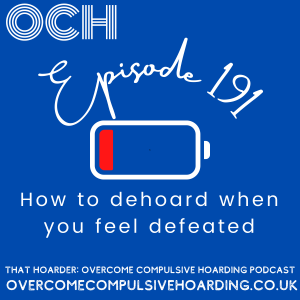
Friday Jun 20, 2025
Friday Jun 20, 2025
Come to a Dehoarding Accountability Zoom Session: http://www.overcomecompulsivehoarding.co.uk/ticket
Subscribe to the podcast: https://www.overcomecompulsivehoarding.co.uk/subscribe
Podcast show notes, links and transcript: http://www.overcomecompulsivehoarding.co.uk/
Feeling defeated by dehoarding? I’ve been there, and I’m trying to get out of it, so in this episode I unpack what’s really behind that sense of hopelessness, breaking it down into manageable pieces, and sharing practical steps for moving forward - even when it all feels impossible. If you’re stuck, overwhelmed, or just too tired to start, you’re not alone. So let’s talk about some concrete things you can try.
Buy your copy of Everything You Need to Know About Hoarding by Dr Lynne Drummond at cambridge.org/EverythingHoarding, and get 20% off with the discount code HOARDING20. #ad
Feeling Defeated by Dehoarding
Host’s recent struggle with feeling defeated and hopeless
Common reasons for feeling defeated:
The enormity of the task
Personal life challenges and lack of time
Breaking down what “defeated” means for individuals
Self-Reflection and Identifying Obstacles
Using self-questioning techniques inspired by CBT
Listing and mapping out the causes of defeat on paper
Examples of personal obstacles:
Fatigue and physical health
Difficulty concentrating
Emotional overwhelm and stress
Shame and self-blame
Sense of impossibility
Breaking Down Barriers and Theme Identification
Categorising specific reasons for defeat
Writing actionable notes beside each challenge
Strategies for managing each obstacle:
Sleep hygiene and physical health maintenance
Working on self-compassion and challenging self-blame
Supporting concentration and mental health through self-care
Trial and error with productivity and to-do lists
Coping with Overwhelm
Recognising overwhelm as a rational but paralysing response
Techniques for reducing overwhelm:
Breaking tasks into tiny, actionable steps
Focusing on achievable mini-goals
Reframing "impossible" goals into manageable actions
Addressing Stress
How personal and environmental stress feeds into defeat
Practical strategies:
Tackling smaller, actionable tasks to relieve work/personal stress
Honest communication with peers, family, and colleagues about overwhelm
Accepting that some sources of stress require long-term coping rather than immediate solutions
Tackling the Sense of Impossibility
Recognising the vagueness of the feeling
Returning to self-analysis to clarify what specifically feels impossible
Using accumulated small improvements to chip away at the larger sense of defeat
Dealing with Overwhelm and Taking Breaks
Granting oneself intentional breaks to refresh perspective without guilt
Comparing dehoarding effort to the need for breaks in work life
Re-evaluating Plans and Expectations
Assessing the effectiveness of current strategies and goals
Adapting goals to current capacity and circumstances
Seeking external feedback and community support
The Importance of Support Systems
Nurturing and expanding support from peers, professionals, and loved ones
Recognising where additional support is needed
Celebrating Small Wins
The importance of acknowledging tiny victories
Suggestions for gentle self-recognition and reward
Recording achievements for self-motivation
Links
Podcast ep 190: What if we forgive ourselves, but now we know better, we do better? Choosing compassion over shame in hoarding disorder
Podcast episode 174: How to feel grounded when we’re overwhelmed or dysregulated using ventral vagal spaces and touchstones, with Dr Jan Eppingstall
Podcast ep 160: Dehoarding with the seasons: get inspired by nature when everything is overwhelming
Podcast ep 16: Dealing with overwhelm
Podcast ep 127: Overcoming overspending with Paige Pritchard, Money Coach
Financial Confessions podcast
Come to a Dehoarding Accountability Zoom session: Accountability Booking Form
Website: Overcome Compulsive Hoarding
Become a Dehoarding Darling
Submit a topic for the podcast to cover
Questions to ask when dehoarding: https://www.overcomecompulsivehoarding.co.uk/podquestions
Instagram: @thathoarderpodcast
Twitter: @ThatHoarder
Mastodon: @ThatHoarder@mastodon.online
TikTok: @thathoarderpodcast
Facebook: Overcome Compulsive Hoarding with That Hoarder
Pinterest: That Hoarder
YouTube: Overcome Compulsive Hoarding with That Hoarder
Reddit: Overcome Compulsive Hoarding with That Hoarder subreddit
Help out: Support this project
Sponsor the podcast
Subscribe to the podcast
Subscribe to the podcast here
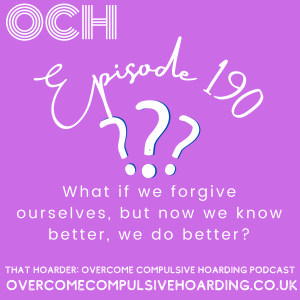
Friday Jun 13, 2025
Friday Jun 13, 2025
Come to a Dehoarding Accountability Zoom Session: http://www.overcomecompulsivehoarding.co.uk/ticket
Subscribe to the podcast: https://www.overcomecompulsivehoarding.co.uk/subscribe
Podcast show notes, links and transcript: http://www.overcomecompulsivehoarding.co.uk/
Today I’m looking at what happens if we forgive ourselves for past hoarding behaviours, why we maybe should, and how we can actually use that insight to make better choices and move forward. I talk honestly about the shame and guilt that keeps so many of us stuck. There’s some reflection on the roots of hoarding, the importance of self-compassion, and why hating ourselves into action just doesn’t work - plus a few practical suggestions for anyone trying to make a change, no matter where you’re starting from.
Buy your copy of Everything You Need to Know About Hoarding by Dr Lynne Drummond at cambridge.org/EverythingHoarding, and get 20% off with the discount code HOARDING20. #ad
Forgiving Ourselves but Doing Better
Exploration of guilt and shame related to hoarding and feeling overwhelmed.
Reflection on self-blame, regret, and paralysis it can cause.
Catholic upbringing: Confession, forgiveness, and the importance of genuine intent to change.
Recognition that hoarding often stems from trauma, loss, fear, anxiety, or neurodivergence.
Discussion of cause and effect - influences behind hoarding behavior.
Emphasis that hoarders are not lazy or bad people, but in a complex situation.
The cycle of self-judgement and the importance of self-compassion as an antidote to shame.
Practical advice: Treat oneself with the compassion you’d offer others, challenging negative self-talk.
How self-criticism can demotivate and hinder progress.
Comparison: Encouraging someone else is more effective than berating oneself.
Understanding mistakes, taking responsibility, and making amends when possible.
The importance of learning from past experiences and committing to doing better.
Practical Strategies for Moving Forward
Suggestions for emotional and action-oriented progress:
Journalling or talking to someone about feelings.
Looking back with compassion to identify patterns and triggers.
Start dehoarding by breaking tasks into small steps.
Avoiding perfectionism; celebrating any progress.
Reference to "towards and away moves" from episode 182 with Dr. Jan Eppingstall.
Identifying values and making choices that align with them.
Finding support from therapists, friends, family, support groups, or accountability sessions.
Acknowledgement that forgiving oneself is challenging but necessary for progress.
Emphasising persistence, compassion, and learning from mistakes.
Encouragement and Validation
Recognition of listeners at various stages of their journey - starting, struggling, making progress, or just listening for now.
Assurance that small steps count and everyone is doing their best.
Emphasis that listeners are not alone.
Links
Podcast ep 181: Past influences and future possibilities: cause and effect and hoarding disorder (plus Podcasthon)
Podcast ep 95: Shame and hoarding with Professor Luna Dolezal
Podcast ep 182: What are “towards and away moves” and what on earth do they have to do with hoarding recovery? With Dr Jan Eppingstall
The Gray Area podcast
Come to a Dehoarding Accountability Zoom session: Accountability Booking Form
Website: Overcome Compulsive Hoarding
Become a Dehoarding Darling
Submit a topic for the podcast to cover
Questions to ask when dehoarding: https://www.overcomecompulsivehoarding.co.uk/podquestions
Instagram: @thathoarderpodcast
Twitter: @ThatHoarder
Mastodon: @ThatHoarder@mastodon.online
TikTok: @thathoarderpodcast
Facebook: Overcome Compulsive Hoarding with That Hoarder
Pinterest: That Hoarder
YouTube: Overcome Compulsive Hoarding with That Hoarder
Reddit: Overcome Compulsive Hoarding with That Hoarder subreddit
Help out: Support this project
Sponsor the podcast
Subscribe to the podcast
Subscribe to the podcast here
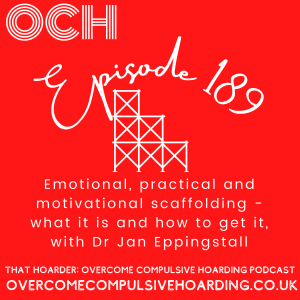
Friday Jun 06, 2025
Friday Jun 06, 2025
Come to a Dehoarding Accountability Zoom Session: http://www.overcomecompulsivehoarding.co.uk/ticket
Subscribe to the podcast: https://www.overcomecompulsivehoarding.co.uk/subscribe
Podcast show notes, links and transcript: http://www.overcomecompulsivehoarding.co.uk/
This week I’m joined by Dr Jan Eppingstall to talk about scaffolding - what it means, how it helps with hoarding recovery, and why our needs for support change over time.
We break down practical, emotional, and motivational scaffolding, from therapy and peer support to self-made systems and the way we talk to ourselves.
If you’ve ever wondered how to find the right kind of help without feeling stuck with it forever, this is the episode for you.
Buy your copy of Everything You Need to Know About Hoarding by Dr Lynne Drummond at cambridge.org/EverythingHoarding, and get 20% off with the discount code HOARDING20. #ad
Explanation of Scaffolding and the Zone of Proximal Development
Definition of scaffolding from educational psychology.
Origins in Lev Vygotsky’s work: helping people accomplish tasks with support.
Relevance to hoarding and recovery.
Application of Scaffolding to Hoarding Recovery
Psychological, cognitive, and emotional elements in hoarding.
Physical and organisational skill deficits in people who hoard.
Differences and interplay between psychological barriers and practical skills.
Illustrating support levels: from high assistance to independence.
Personal examples demonstrating that support needs can resurface over time.
The Changing Nature of Scaffolding
Scaffolding shifts in form and amount as people progress or encounter setbacks.
Individualisation: What’s supportive for one may not be for another.
Types of Scaffolding for Hoarding Recovery
External supports: therapists, peers, coaches.
Direct instruction and physical assistance.
Environmental modifications.
Tools and resources.
Social encouragement and accountability.
Assessing current functioning.
Matching support to challenge level (not too easy, not too hard).
Gradually reducing support as independence grows.
Scaffolding for Neurodivergent Individuals
Adjustments for ADHD:
Shorter work periods, built-in breaks.
Accountability partners and visual reminders/checklists.
Adjustments for Autism:
Predictable routines.
Clear rules and decision trees.
Sensory-friendly environments.
Executive Function Challenges and Tailored Scaffolding
Strategies like breaking down decisions, using templates, "parking lot" systems for deferred decisions.
Recognising that executive function can be context-specific and fluctuate.
Importance of Emotional Scaffolding
Emotional regulation during dehoarding.
Need for self-soothing and distress-tolerance skills as support is reduced.
Informal and Internal Scaffolding
Peer support, self-talk, problem solving, reminders.
Adapting systems in the home as a supportive structure.
Habituation and Evolvement of Support Systems
Reminder fatigue and strategies to combat it (rotating formats, colours, locations).
The necessity for systems to evolve as needs and effectiveness change.
Mindset Shifts and Realistic Expectations
Acceptance that supports may need to be re-engaged during crises or setbacks.
Not viewing return to scaffolding as failure - progress and healing aren’t linear.
Testing assumptions about personal limitations.
Re-evaluating and Customising Support
Creating, testing, and modifying practical systems in the home with or without outside perspective.
Recognising the value of trying new strategies even if initial skepticism exists.
Links
Zone of Proximal Development
The Metaphor of Scaffolding: Its Utility for the Field of Learning Disabilities, Stone, C. Addison, Journal of Learning Disabilities, 0022-2194, July 1, 1998, Vol. 31, Issue 4
Podcast ep 183: ADHD, executive dysfunction and creating hacks and systems to reduce clutter chaos, with Carrie Lagerstedt
Money Love podcast
Podcast ep 127: Overcoming overspending with Paige Pritchard, Money Coach
Come to a Dehoarding Accountability Zoom session: Accountability Booking Form
Dr Jan Eppingstall at Stuffology
https://www.facebook.com/stuffologyconsulting/
https://twitter.com/stuff_ology
https://www.instagram.com/stuff_ology/
Dr Jan Eppingstall on Pinterest
Website: Overcome Compulsive Hoarding
Become a Dehoarding Darling
Submit a topic for the podcast to cover
Questions to ask when dehoarding: https://www.overcomecompulsivehoarding.co.uk/podquestions
Instagram: @thathoarderpodcast
Twitter: @ThatHoarder
Mastodon: @ThatHoarder@mastodon.online
TikTok: @thathoarderpodcast
Facebook: Overcome Compulsive Hoarding with That Hoarder
Pinterest: That Hoarder
YouTube: Overcome Compulsive Hoarding with That Hoarder
Reddit: Overcome Compulsive Hoarding with That Hoarder subreddit
Help out: Support this project
Sponsor the podcast
Subscribe to the podcast
Subscribe to the podcast here
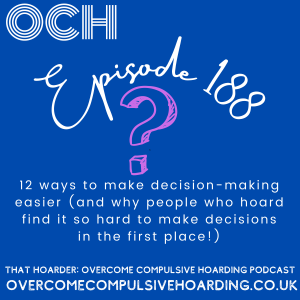
Friday May 30, 2025
Friday May 30, 2025
Come to a Dehoarding Accountability Zoom Session: http://www.overcomecompulsivehoarding.co.uk/ticket
Subscribe to the podcast: https://www.overcomecompulsivehoarding.co.uk/subscribe
Podcast show notes, links and transcript: http://www.overcomecompulsivehoarding.co.uk/
Decision-making can be a huge stumbling block when you’re trying to tackle hoarding, from cognitive overload to perfectionism and decision fatigue. In this episode, I unpack why making choices about our belongings feels so overwhelming, what can go wrong if we avoid it, and I share practical strategies to make the process more manageable. If you find yourself stuck in analysis paralysis or endlessly putting off decisions, this one’s for you.
Buy your copy of Everything You Need to Know About Hoarding by Dr Lynne Drummond at cambridge.org/EverythingHoarding, and get 20% off with the discount code HOARDING20. #ad
Introduction to Decision Making and Hoarding
Decision making as a common issue among hoarders
Overwhelm and avoidance connected to belongings and acquiring new items
Episode aims: understanding why decision making is hard, consequences of indecision, and strategies to help
Why Decision Making is Difficult for People Who Hoard
Cognitive Overload
Too many items to process, making each choice feel monumental
Resulting in avoidance and deferral of decisions
Accumulation due to unresolved decisions
Analysis Paralysis
Being stuck analysing endless options and outcomes
Difficulty prioritising and overthinking decisions
Exhaustion from mental effort
Information Processing Challenges
Trouble prioritising urgency and importance
Struggling to filter necessary versus unnecessary information
Being trapped in unresolvable decision loops
Emotional Barriers
Perfectionism and fear of making the wrong decision
Catastrophising possible negative outcomes
All-or-nothing thinking relating to perfectionism
Sentimental Attachment
Struggles with emotional connection to items (gifts, memories)
Difficulty discerning genuine sentimental value
Fear of the Future
Anxiety about future need or regret causing paralysis
Preference for clinging to items over risking discomfort
Executive Function Challenges
Difficulties with planning, organising, prioritising, and initiating tasks
Impact of poor working memory on decision making
Consequences of Avoiding Decisions
Vicious Cycle of Procrastination
Accumulation of clutter, increased overwhelm and fatigue
Practical Implications
Safety hazards and restricted home usage
Social isolation and relationship strain due to inability to host
Emotional Impact
Stress, depression, guilt, and shame
Financial Consequences
Extra spending, buying duplicates, damage or loss of items, missed bills and penalties
Building Negative Self-Perceptions
Belief in inability to decide reinforces avoidance
Declining self-trust and self-esteem
Strategies and Techniques for Improving Decision Making
Identify Resistance and Mental Blocks
Questioning internal "nope" responses
Understanding fears or overwhelming factors behind avoidance
Treat Decisions as Experiments
Lowering pressure by seeing outcomes as learning experiences
Avoiding a pass/fail mindset
Make Micro-Decisions
Starting with low-stakes, emotionally neutral items
Building decision-making confidence ("decision muscle")
Utilise Support Systems
Seeking feedback or accountability from friends, family, organisers, or therapists
Sense-checking and encouragement from others
Clarify Values and Priorities
Aligning decisions with personal goals (e.g., hospitality, functionality, beauty)
Using values as a decision compass
Set Time Limits
Imposing limits per decision to prevent overthinking
Adjusting duration as confidence improves
Accept “Good Enough” Decisions
Allowing for adequacy over perfection
Challenging double standards around self-expectations versus others
Reduce Number of Choices
Limiting possible options (e.g., keep/throw/donate)
Pre-determining criteria to streamline choices
Reality Checks
Probing feelings of “I might need it” with practical questions
Reviewing usage frequency and functionality
Increase Awareness of Avoidance
Noticing procrastination and avoidance behaviours
Evaluating the significance of indecision as a barrier
Build Tolerance for Uncertainty and Discomfort
Accepting that discomfort is part of life, and not deciding brings other difficulties
Gradually practicing sitting with uncertainty
Practice Consistency in Decision Making
Incorporating daily decision-making habits
Gently challenging avoidance and celebrating each choice made
Decision-making is a learnable, improvable skill
The importance of starting small and practicing imperfect decisions
Building self-trust and confidence through repeated practice
Encouragement to challenge avoidance and recognise growth with each decision
Links
Buy your copy of Everything You Need to Know About Hoarding by Dr Lynne Drummond at cambridge.org/EverythingHoarding, and get 20% off with the discount code HOARDING20.
Podcast ep 172: Harriet Impey on clearing out her parents’ very full home, through family belongings and personal growth, in the film Where Dragons Live
Podcast ep 186: 10 executive dysfunction tips and tricks to help people who hoard, whether we have ADHD or are neurodivergent or not – Hoarding Awareness Week 2025
Podcast ep 183: ADHD, executive dysfunction and creating hacks and systems to reduce clutter chaos, with Carrie Lagerstedt
Podcast ep 162: From Fibble to Focus: Defibble your executive dysfunction with Jo Cavalot
Podcast ep 112: Executive function, executive dysfunction and hoarding with Dr Jan Eppingstall
Podcast ep 149: ADHD, hoarding and clutter with Susie Boutal, ADHD and Declutter Coach
Podcast ep 107: Things that look like hoarding but aren’t: ADHD, depression, autism, OCD, OCPD and more
Podcast ep 40: ADHD and hoarding with Dr Sharon Morein
Podcast ep 182: What are “towards and away moves” and what on earth do they have to do with hoarding recovery? With Dr Jan Eppingstall
Podcast ep 28: Avoid analysis paralysis by having ‘systems’
Podcast ep 49: Sitting with discomfort: distress tolerance and hoarding – How unconscious distress avoidance might be worsening your problems
Reasons to be Cheerful with Ed Miliband
Come to a Dehoarding Accountability Zoom session: Accountability Booking Form
Website: Overcome Compulsive Hoarding
Become a Dehoarding Darling
Submit a topic for the podcast to cover
Questions to ask when dehoarding: https://www.overcomecompulsivehoarding.co.uk/podquestions
Instagram: @thathoarderpodcast
Twitter: @ThatHoarder
Mastodon: @ThatHoarder@mastodon.online
TikTok: @thathoarderpodcast
Facebook: Overcome Compulsive Hoarding with That Hoarder
Pinterest: That Hoarder
YouTube: Overcome Compulsive Hoarding with That Hoarder
Reddit: Overcome Compulsive Hoarding with That Hoarder subreddit
Help out: Support this project
Sponsor the podcast
Subscribe to the podcast
Subscribe to the podcast here
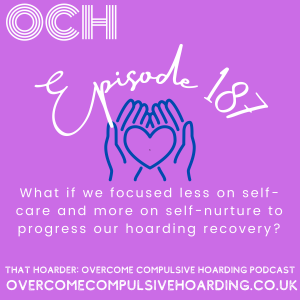
Friday May 23, 2025
Friday May 23, 2025
Come to a Dehoarding Accountability Zoom Session: http://www.overcomecompulsivehoarding.co.uk/ticket
Subscribe to the podcast: https://www.overcomecompulsivehoarding.co.uk/subscribe
Podcast show notes, links and transcript: http://www.overcomecompulsivehoarding.co.uk/
Self-care gets a lot of airtime these days, but I’ve started rethinking what it actually means, especially when you’re struggling with hoarding disorder. In this episode, I talk about why marketed, consumer-driven “self-care” just adds more pressure, and why nurturing yourself with compassion, connection, and practical routines is far more effective. Plus, I share some genuinely helpful, low-cost ways to support yourself without adding to the clutter - or your to-do list.
Self-Care in Modern Times
Evolution of the meaning of “self-care”:
The older, practical definition (basic hygiene, nourishment)
Current consumer-driven, extravagant interpretations
Critique of modern self-care commercialisation
Challenges of Hoarding and Mental Health Struggles
Emotional toll of hoarding disorder
Stress, anxiety, depression, trauma, grief
The exhausting process of trying to “fix” things
Daily stressors of living in a hoard
Feelings of failure, constant reminders, adrenaline spikes from unexpected visitors, tripping over items
The Real Purpose of Self-Care
Balancing negative emotions (stress, grief, trauma) with activities that nurture the soul
Evaluating popular self-care advice
The problem with universal, commercialised recommendations
Importance of individualised, inward-looking approaches
Introducing the Concept of "Self-Nurture"
How self-nurture differs from self-care
Greater compassion, sustainability, and personalisation
Emphasis on looking inwards for individual needs
Practical examples of self-nurturing activities
The Pitfalls of Commercialised Self-Care
The “shoulds” culture and guilt surrounding unmet self-care standards
Surface-level versus meaningful acts of care
How marketed solutions often do not address real needs
Guilt and shame when unable to practice recommended self-care (especially for those who hoard)
Consumer Culture and Self-Care
Self-care as a commodified experience: Encouragement to buy unnecessary products
How this affects people who hoard
Risk of exacerbating clutter by acquiring more as “self-care”
Focus on external fixes rather than internal wellbeing
The Benefits of Self-Nurture
Self-nurture as inexpensive or free
Focus on activities rather than acquisitions
Finding joy or restoration in simple practices (e.g., using what you have, accessing the library, running without specialised gear)
Compassionate Self-Nurture in Practice
Asking internal questions about core needs (physical, emotional, psychological)
Treating oneself as one would treat a person they love
Emphasis on gentle, non-critical, incremental progress
Drinking water for wellbeing rather than obligation
Time in nature, connecting with friends, creativity, self-acceptance
Building Emotional Security and Gentleness
Establishing emotional security as a core need
Managing self-criticism and reaching out for connection despite anxiety
Celebration of small wins and progress
Validating and acknowledging difficult feelings with compassion
Evaluating and Choosing Nurturing Activities
Key questions to ask: “Will this nurture me emotionally, psychologically, or physically?”
Differentiating between genuine needs and justifying unnecessary purchases
Avoidance of reinforcing negative patterns through acquisition
Developing a Personal Toolbox for Self-Nurture
Gathering and customising strategies that work
Routines and coping mechanisms
Taking stock of helpful techniques, personalising approaches
Recognising and valuing unique sources of restoration
Top Tip
DIY, low-cost tip for cleaning the dishwasher with household items
Encouragement to take any step, however small, towards self-nurture
Links
The "feeling your feelings" episode
Episodes talking about the inner critic: with Steve Chapman; about the song that changed everything for me; and about making mistakes
Come to a Dehoarding Accountability Zoom session: Accountability Booking Form
Website: Overcome Compulsive Hoarding
Become a Dehoarding Darling
Submit a topic for the podcast to cover
Questions to ask when dehoarding: https://www.overcomecompulsivehoarding.co.uk/podquestions
Instagram: @thathoarderpodcast
Twitter: @ThatHoarder
Mastodon: @ThatHoarder@mastodon.online
TikTok: @thathoarderpodcast
Facebook: Overcome Compulsive Hoarding with That Hoarder
Pinterest: That Hoarder
YouTube: Overcome Compulsive Hoarding with That Hoarder
Reddit: Overcome Compulsive Hoarding with That Hoarder subreddit
Help out: Support this project
Sponsor the podcast
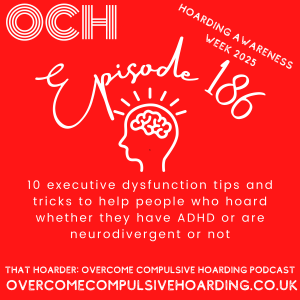
Friday May 16, 2025
Friday May 16, 2025
Come to a Dehoarding Accountability Zoom Session: http://www.overcomecompulsivehoarding.co.uk/ticket
Subscribe to the podcast: https://www.overcomecompulsivehoarding.co.uk/subscribe
Podcast show notes, links and transcript: http://www.overcomecompulsivehoarding.co.uk/
For Hoarding Awareness Week 2025, I’m focusing on executive function - the brain’s control centre for planning, starting, and finishing tasks - and the small, practical hacks that can make a genuine difference for people who hoard, whether or not we have ADHD or are neurodivergent. I talk about real-life tips for breaking the overwhelm, managing perfectionism, building momentum, and overcoming shame, all with the aim of making progress sustainable and achievable in your day-to-day life. This episode is all about honest advice that actually works, whether you’re in the thick of it or just looking for a few smarter ways to approach this.
Hoarding Awareness Week 2025 and its theme: Hoarding & Executive Function
Recognition that executive function challenges impact both neurodivergent and neurotypical people
Executive Function and Hoarding
Previous podcast episodes relating to executive function, ADHD, and hoarding
Importance of using effective hacks and techniques, regardless of neurotype
Emphasis on finding what works personally for each listener
The Realities and Challenges of Tackling Hoarding
Overwhelm and daunting feelings about dehoarding
Breaking tasks into small, manageable parts
Focus on actionable, day-to-day strategies rather than long-term, rigid planning
Understanding Executive Function
Explanation of what executive function is (control centre for planning, focus, and impulse control)
Factors that can impair executive function (neurodivergence, mental health, stress, lack of sleep, etc.)
Universality of executive dysfunction - everyone struggles at times
Emotional Barriers: Perfectionism and Shame
The cycle of shame and self-blame in executive dysfunction and hoarding
Societal judgment around hoarding, and its paralysing effects
Strategies for stepping back, naming emotions, and cultivating self-compassion
Core Executive Dysfunction Tips and Hacks
Breaking Tasks Down
Setting realistic micro-goals
The concept of “towards” vs. “away” moves in progress
Tracking Progress
Counting bags/items leaving the house
Caution against tracking becoming burdensome for some
Using Timers
Setting short (e.g., 5-minute) timers to help with task initiation
Use of voice assistants to avoid distraction
Reverse-timer technique to use end of music/podcast as a cue for action
The Two-Minute Rule
Limitations and personal adaptations of rule
Identifying Motivations
Creating visual or written reminders of why you want to dehoard
Acceptance of some tools working only temporarily, and switching when necessary
Reward Systems
Small, non-material rewards for completing tasks
Linking listening to desired media (like the podcast) with decluttering activities
Non-Negotiable Rules
Creating routines to reduce decision fatigue (e.g., charity bags leave home immediately)
Body Doubling
Doing tasks alongside others (physically or virtually, like in the host’s Zoom sessions)
Emotional/moral support of parallel accountability
Alternative ways to body double if group support isn’t accessible
Time Blocking and Scheduling
Using calendars and reminders to schedule decluttering sessions
Flexibly adapting this strategy based on personal response
Habit Stacking
Linking a new task to an established routine (e.g., unloading dishwasher while kettle boils)
Using “add-ons” for frequently-visited spaces (e.g., clearing five things each time you enter the bathroom)
Links
Podcast ep 183: ADHD, executive dysfunction and creating hacks and systems to reduce clutter chaos, with Carrie Lagerstedt
Podcast ep 162: From Fibble to Focus: Defibble your executive dysfunction with Jo Cavalot
Podcast ep 112: Executive function, executive dysfunction and hoarding with Dr Jan Eppingstall
Podcast ep 149: ADHD, hoarding and clutter with Susie Boutal, ADHD and Declutter Coach
Podcast ep 107: Things that look like hoarding but aren’t: ADHD, depression, autism, OCD, OCPD and more
Podcast ep 40: ADHD and hoarding with Dr Sharon Morein
Podcast ep 82: Dehoarding when you’re drowning with KC Davis of Struggle Care
Podcast ep 182: What are “towards and away moves” and what on earth do they have to do with hoarding recovery? With Dr Jan Eppingstall
Podcast ep 184: What if we actually felt the feelings? An honest conversation about trauma, hoarding, and allowing yourself to feel
Podcast ep 28: Avoid analysis paralysis by having ‘systems’
Arielle and Ned's Daily Tips That May or May Not Help You
Come to a Dehoarding Accountability Zoom session: Accountability Booking Form
Website: Overcome Compulsive Hoarding
Become a Dehoarding Darling
Submit a topic for the podcast to cover
Questions to ask when dehoarding: https://www.overcomecompulsivehoarding.co.uk/podquestions
Instagram: @thathoarderpodcast
Twitter: @ThatHoarder
Mastodon: @ThatHoarder@mastodon.online
TikTok: @thathoarderpodcast
Facebook: Overcome Compulsive Hoarding with That Hoarder
Pinterest: That Hoarder
YouTube: Overcome Compulsive Hoarding with That Hoarder
Reddit: Overcome Compulsive Hoarding with That Hoarder subreddit
Help out: Support this project
Sponsor the podcast
Subscribe to the podcast
Subscribe to the podcast here
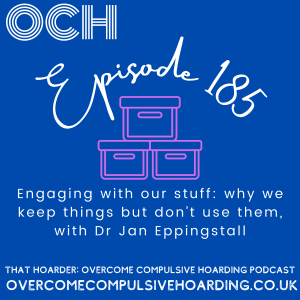
Friday May 09, 2025
Friday May 09, 2025
Come to a Dehoarding Accountability Zoom Session: http://www.overcomecompulsivehoarding.co.uk/ticket
Subscribe to the podcast: https://www.overcomecompulsivehoarding.co.uk/subscribe
Podcast show notes, links and transcript: http://www.overcomecompulsivehoarding.co.uk/
In this episode, I’m with Dr Jan Eppingstall, a Melbourne-based counsellor and hoarding expert extraordinaire. We unpack the concept of engaging with our belongings - actually seeing, touching, and using the things we tend to accumulate, rather than letting them fade into the background. Jan shares insights from her work, explains why we often feel safer just owning stuff instead of interacting with it, and offers practical ways to build a healthier, more intentional relationship with what we own. There are some genuinely enlightening moments, and plenty of ideas for anyone looking to break free from an excess of stuff.
Defining "Engaging with Our Stuff"
What it means to actually engage with possessions (seeing, touching, using)
Comparison to possessions fading into the background
The idea of using versus just possessing objects
Patterns of Engagement Among People Who Hoard
Sense of safety from being surrounded by possessions without interaction
Only the "top layer" of possessions typically being used
Loss of intention behind keeping sentimental or useful items
The psychological comfort of having versus using objects
Emotional and Psychological Aspects of Compulsive Hoarding
Emotional connection to the potential of objects rather than actual objects
Avoidance of decision-making by not engaging/touching items
Security and reassurance derived from the mere presence of items
Defeatism and pointlessness associated with searching for or using objects
Barriers to Engaging with Possessions
Overwhelm from the sheer volume of stuff
Active resistance and avoidance behaviours
Feelings of incompetence and adaptation through purchasing duplicates
Guilt associated with over-accumulation
Benefits of Actively Engaging with Possessions
Rediscovering useful or wanted items when sorting
Increased awareness of what is owned and where it is
Neurological and psychological benefits of tactile interaction
Insights gained from using and trying on items (e.g., clothing)
Decision-making as a muscle that strengthens with practice
Realisations about unnecessary duplicates (e.g., multiple ladles in the kitchen)
Emotional and practical hurdles in finding homes for items
Perfectionism and rigidity around item placement and organisation
Moving, Arranging, and Re-organising Possessions
Resistance to moving items from "their place" due to tradition, attachment, or perfectionism
Fear of forgetting where things are if organisational changes are made
Multi-step decision fatigue when organising
The importance of flexible, evolving systems for item placement
Confronting Avoidance and Overwhelm
The value of small steps, e.g., simply looking into an avoided bag or space
The myth of a “good reason” for keeping certain items, often dispelled when items are revisited
Developing Healthier, More Intentional Relationships with Stuff
Introducing intention and ritual to everyday interactions with possessions
“Rotation stations” and seasonal evaluation/rituals
Benefits of conscious handling, organisation, and maintenance
Cultural Perspectives and Practices
Japanese concepts:
Te Ate: hand-care, tactile connection as a ritual
Mushiboshi: seasonal airing and assessment of items
Ma: meaningful emptiness/space as a source of tranquillity
Contrasts between Western consumerism and other cultural approaches to possessions
Challenges and Solutions in Organising and Letting Go
The impact of spatial processing or organisational difficulties
Accepting that resistance to change is sometimes due to overwhelm
Personalisation and Flexibility in Managing Possessions
Tailoring organisation and engagement to one’s own needs, routines, and neurodiversity
Maximalism and the need for varying levels of stimulus—distinguishing between maximalism and chaos
Allowing spaces to be intentionally clear, embracing the benefits of emptiness
The ongoing journey of developing intentionality with possessions
The importance of kindness and patience with oneself in making these changes
Links
Podcast ep 146: Where Dragons Live and what we leave behind
Podcast ep 172: Harriet Impey on clearing out her parents’ very full home, through family belongings and personal growth, in the film Where Dragons Live
How to watch Where Dragons Live
Podcast ep 53: The Endowment Effect and hoarding – How this cognitive bias makes you feel the need to keep everything
Podcast ep 124: How the little-known Hummingbird Method can help you to dehoard the areas you’ve been avoiding
Podcast ep 74: Couples and hoarding: An interview with Laura Silverstein, Certified Gottman Couples Therapist
Podcast ep 140: How to cope with – or help – a partner who hoards, with Laura Silverstein, Certified Gottman Couples Therapist
Podcast ep 183: ADHD, executive dysfunction and creating hacks and systems to reduce clutter chaos, with Carrie Lagerstedt
Elis James and John Robins podcast
Come to a Dehoarding Accountability Zoom session: Accountability Booking Form
Dr Jan Eppingstall at Stuffology
https://www.facebook.com/stuffologyconsulting/
https://twitter.com/stuff_ology
https://www.instagram.com/stuff_ology/
Dr Jan Eppingstall on Pinterest
Website: Overcome Compulsive Hoarding
Become a Dehoarding Darling
Submit a topic for the podcast to cover
Questions to ask when dehoarding: https://www.overcomecompulsivehoarding.co.uk/podquestions
Instagram: @thathoarderpodcast
Twitter: @ThatHoarder
Mastodon: @ThatHoarder@mastodon.online
TikTok: @thathoarderpodcast
Facebook: Overcome Compulsive Hoarding with That Hoarder
Pinterest: That Hoarder
YouTube: Overcome Compulsive Hoarding with That Hoarder
Reddit: Overcome Compulsive Hoarding with That Hoarder subreddit
Help out: Support this project
Sponsor the podcast









